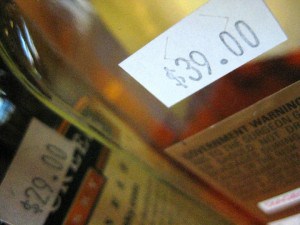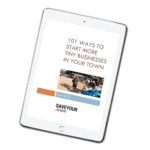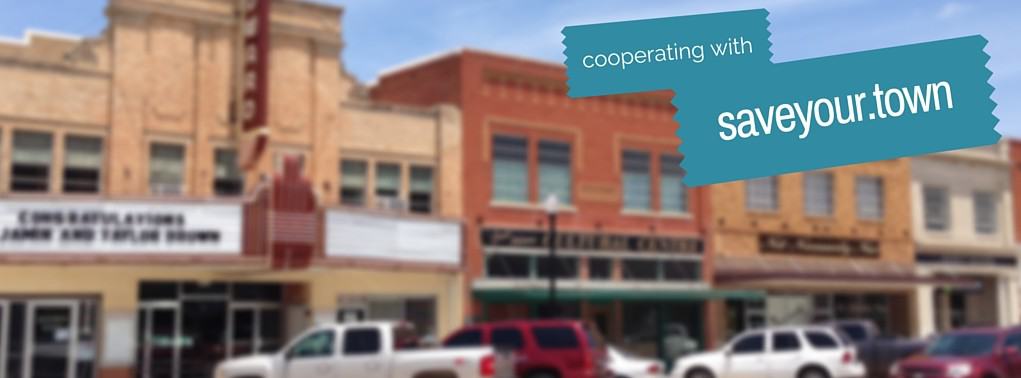
It’s just a little price sticker, so why should it be so hard to decide what price to put on it? Photo by Becky McCray.
Setting retail prices is like some arcane art form. How the heck are you supposed to figure out what to markup items in your retail business when no one wants to give you real numbers?
Here are two starting points for setting retail prices and markups.
Keystoning
Keystone pricing is simple and fairly common. Take the price you paid for an item, double it, and that is your retail price. That’s a markup of 100%.
Now, before you blow a gasket, realize that that is not outrageous. You have to pay all your other expenses out of that: salaries, utilities, advertising, loan payments, and any other expenses. Oh, if there’s anything left over you can think about saving up a cash cushion or even paying yourself a profit.
There are lots of variations for keystone pricing. One small town clothing store I know uses double plus 10%. It is working fairly well for them. They aren’t getting rich, but they are prospering.
But how do you know what is usual in your industry? You can ask other stores in your same retail segment, but in another town. (Pick a town somewhat similar to your own, and fairly far away.) They still may not tell you anything, because retailers are notoriously close-mouthed about markups. But don’t despair. We have another source.
Industry Benchmarks
The Retail Owners Institute has benchmark performance metrics for 52 retail segments publicly available at no cost. (Bless their hearts!) It’s in the section labeled Store Benchmarks.
Find the closest match for your retail segment, then find gross margin. It shows you how much of each sale was left over after paying for the merchandise. That’s an upside down measure of markup.
Let’s work an example. The average gross margin for Gift, Novelty and Souvenir Stores was 47.9% in 2009. So on a $100 item, on average the store paid $52.10 for the merchandise, and had $47.90 in gross margin to pay for everything else. Now we just have to convert that into a markup.
How to translate a gross margin percentage into a markup percentage:
- Convert the gross margin percent into a decimal: 47.9% = .479
- Find the gross cost: 1 – .479 = .521
- Invert it: 1 / .521 = 1.919
- Subtract one: 1.919 – 1 = 0.919
- Convert back into a percentage: 0.919 = 91.9%
- That’s the markup: 91.9%
That’s pretty close to keystone (100%), isn’t it? That’s probably what most gift retailers are using.
So, now some of you are wondering what to do with that markup percentage. That’s pretty easy.
How to figure a retail price from a markup percentage:
- Convert the markup percent into a decimal: 91.9% = .919
- Add one: .919 + 1 = 1.919
- Multiply 1.919 times the wholesale price.
- The answer is your retail price.
If this were my store, I’d round off to 92%, 95%, or maybe even 100%. No need to be overly-precise.
All of this is just to give you a starting point. You will want to adjust up or down, based on what makes sense for your business.
Small town retail reality
Generally, a retail store in a smaller town will charge a higher markup than one in a larger urban area. That’s because the small town business has more transportation costs, fewer customers, lower sales volume, or fewer direct competitors. Don’t use that as an excuse, but do take your customer base into account.
Test pricing
So if you were in the gift retail segment, you might take several items and test price them. Multiply the wholesale price by 2 to get your proposed retail price. Compare that to other retailers, including online. Would you be competitive? Would that work for your business?
Now that we’ve gotten you started, it’s up to you. Run the numbers on your business. And if you have any questions or hard-won insights on pricing, please jump right in to the comments. We’d love to hear them.
You’re not alone
It’s normal for this to be difficult. Every retail business in a small town struggles with pricing issues. Hundreds of other business owners just like you read this post every week. You’re not alone. We’re all in this together.
Sign up here to get our newsletters and articles:
You can unsubscribe or change your subscription anytime.
I will not sell or rent your name to anyone else because I wouldn’t like that either.

101 Ways to Start More Tiny Businesses
If you need more business ideas, 101 Ways to Start More Tiny Businesses is a short ebook detailing ways to spread economic opportunity as well as why tiny businesses matter. Sign up here to download it and you’ll also get our weekly newsletters where Deb Brown and I share practical steps you can put into action right away to shape the future of your town. Download 101 Ways here.
I will never sell or rent your email address to anyone else because I wouldn’t like that either.
This article is cited in the following academic publications:
- Scaling of Greenhouse Crop Production in Low Sunlight Environments, Kyle A. Alvarado, Aron Mill, Joshua M. Pearce, Alexander Vocaet, David Denkenberger, University of Alaska Fairbanks, pre-print Science of the Total Environment, 2019
- Potential of microbial electrosynthesis for contributing to food production using CO2 during global agriculture-inhibiting disasters, Juan B. García Martínez, Michael M. Brown, Xenia Christodoulou, Kyle A. Alvarado, David C. Denkenberger, Cleaner Engineering and Technology, Volume 4, October 2021
- Synthetic fat from petroleum as a resilient food for global catastrophes: preliminary techno-economic assessment and technology roadmap, Juan B. García Martínez, Kyle A. Alvarado, David C. Denkenberger, University of Alaska Fairbanks, Chemical Engineering Research and Design, 2021
- Methane Single Cell Protein: Potential to Secure a Global Protein Supply Against Catastrophic Food Shocks Juan B. García Martínez, Joshua M. Pearce, James Throup, Jacob Cates, Maximilian Lackner, David C. Denkenberger, Front. Bioeng. Biotechnol., Volume 10 – 2022 | https://doi.org/10.3389/fbioe.2022.906704
- About the Author
- Latest by this Author
Becky started Small Biz Survival in 2006 to share rural business and community building stories and ideas with other small town business people. She and her husband have a small cattle ranch and are lifelong entrepreneurs. Becky is an international speaker on small business and rural topics.











Thanks for the explanation of margin and markup, Becky. There is also a huge challenge for service businesses to decide what to charge because there is no cost of goods as a baseline. It’s been my experience that service businesses tend to shoot too low when setting prices. That hurts them in the long-run because they have set a price baseline that is too low.
This is great information, I’m going to make sure Mr. Bruce reads it.
Jay, you are right that service providers tend to set their prices too low when starting out. We need a whole article on setting service business prices.
Miss Dazey, glad it’s useful.
I’m sharing the link with my innkeeper group. Many have gift shops and this is often a concern.
Thanks, Seely. Glad to know you’re sharing it.
I have x, price with overhead is $155. If I charge double, 100% does that mean I am getting 50%?
problem:
item x $119
overhead $35.70
then I add it together 154.70
mark up/profit on the ITEM ONLY, not on overhead by 175% $207.06
Add both: 361.76
add cc fees: 3.6% 13.02
final price: 374.78
SHOULD I add mark up and base cost? I feel I’m doing something wrong, but don’t know what it is.
As far as I know, most retailers do not markup their overhead and most take their overhead (including credit card fees) out of the markup. So it would be wholesale cost times markup percentage, or 119 x 1.75 = 208.25.
That said, there are no rules. Pick a price and test it. That is the only way to find out.
Retail Markups are based on Selling price, not cost. The example shown is a Mark-On. The markup in the example is a 50% markup, meaning that of the retail price 50% is markup and 50% is cost.
The correct forumula to computer Retail selling price is
Cost / (1 – Markup) where markup is expressed as a decimal value. A 50 percent markup would be 0.50. To arrive at the selling price, take the cost and divide by (1-.50) or .50 which is to double the cost.
A 35 percent markup on a 100 item is $100 / (1 – 0.35) = $100 / .65 = $153.85/
In a retail business income statement, total sales is considered 100%. If all products are marked up using 35% markup as shown the gross margin on sales, that is Sales minus COGS (Cost of Goods Sold) would be 35 percent. This is why markups are computed this way, so there are no surprises when the financial statements are prepared.
Many sites mistakenly discuss markup as something you add to cost, instead of the slightly more complicated (but accurate) answer that markup is based on selling price, and arriving at the selling price when you know the markup and cost is really COST / (1-MU) instead of COST x (1+MU)
Look hard, you’ll find the right answer in books written by retail experts.
Jeff, thanks for adding the academic and financial statement definitions. While they don’t help with the practical questions for retail store owners, they add more context.
Okay….can someone clarify what Jeff Towle is illustrating and put it in lay mans terms?
Well, it’s the financial statement definition. So this is how you look at markup after the fact. If you know what the total sales were and what costs turned out to be, you can figure markup from that. But that’s after the sales are made. To me, it’s not particularly useful when you are trying to figure out what price to put on an item to sell.
How do you figure pricing if you are producing small individual items. The items I am producing cost me .07999¢ each in materials and about 2 minutes to produce. Shipping costs are determined by quanity. How much do I charge if selling them at a retail?
Thanks,
Mike Lafoote
Mike, that’s a great question. I will get to work on a new article on how to price products you are producing for both retail and wholesale sales.
Mike, the new article on pricing products you make is now up:
How to price items you produce or make
Thanks for asking a great question!
Here’s one I’ve had success with.
How to Calculate Your Ad Budget
Calculating the Minimum & Maximum to Spend
This guide will help you compute the minimum and maximum you should spend on advertising based on the margin and markup of your average sale.
The Company
$1Million in Sales, Profit Margin of 48%, rent is $36,000 annually.
Where to Start
The first thing we must do is compute 10% and 12% of your projected annual, gross sales and multiply each by markup made on the average transaction. 10% of $1M in sales =$100,000; 12% of $1M in Sales = $120,000.
Convert margin to markup
Divide Total Gross Profits by Cost. $1M in sales = $480,000 (gross profits) / $520,000 (hard costs) = 92.3% Markup.
Computing the High and Low You Can Spend
92.3% times $100,000 (10% of sales) = $93,300
92.3% times $120,000 (12% of sales) = $110,760
Final Step – Subtract Your Rent
Why subtract the rent? At this point you may find you have spent your entire advertising budget on your rent. You might have a small amount left or a sizable figure left. Either way you have a much clearer picture of your advertising budget and how to allocate your funds. Plus the higher your rent the more likely you are to have high visibility. Get a bigger sign.
Using your calculations from above:
Low $93,300 minus $36,000 (yearly rent) = $56,300
High $110,760 minus $36,000 (yearly rent) = $74,760
The Low You Can Spend On Advertising is $56,300
The High You Can Spend On Advertising is $74,760
Tom, that is a useful guideline. Thank you very much for sharing it.
The formularies seems to be a bit tedious as a means to an end. One of my competitors charges a roughly 40% markup on some items and triple to quadruple on others. The 40% up items have a suggested retail much higher than what they are charging. Example: widget A suggested retail is $560. I use my multiplier to find cost, which is .3848, so 560 x .3848 give me a cost of $215.49. I double that to $430.98 to keep my profit and give my clients a better than retail price. My competitor, on the other hand, sells the same item from the same manufacturer for $299. It is possible they have a better multiplier from the manufacturer as a volume discount, but their $299 works out to about 40% profit and mine is 100%. They sell MANY more than I by far and pricing may be why. Widget B they sell for a HUGE markup and they still have a much higher volume. Still trying to figure this one out.
Ben, you’re definitely in a market with highly variable pricing. Sounds like you’re up against a competitor who uses one item as a loss leader and then make their money on the other items. What it comes down to is psychology, human behavior. The numbers can only take you so far. After that, you have to just try things and learn from your experiments.
David Olivier sent this via the contact form:
Just a comment that to me what your site defines as a ‘gross margin’ turns commonsense on its head although I know it’s common amoing retailers to express it this way.
Mathematically, a shopkeeper’s gross margin in percent is:
100 x (retail selling price – wholesale buying price) / (buying price)
So, if he buys for 5 and sells for 10 ($ or £), his markup is
100 x (10 -5) / 5 = 100 %.
It’s not 50%.
My guess is that’s it’s been ‘sanitised’ by retailers so that their percentage gross profits sound lower to the general public.
It’s still useful though. I can’t find anything in the UK that openly discusses these margins. I’m selling some secondhand goods to a dealer so I want to know what he’s likely to be making on the deal before I negotiate.